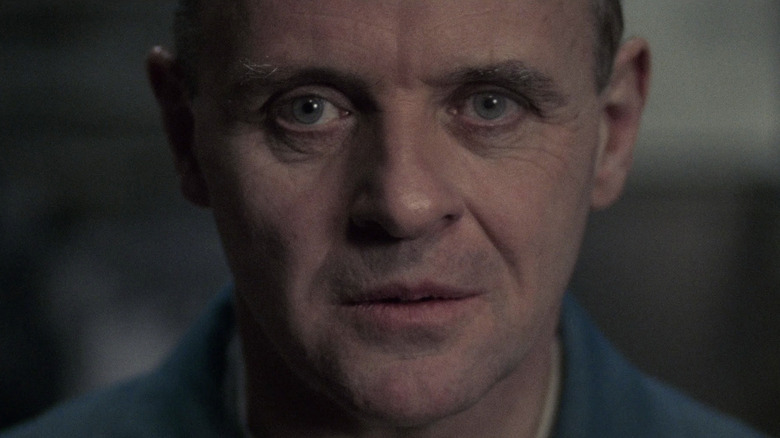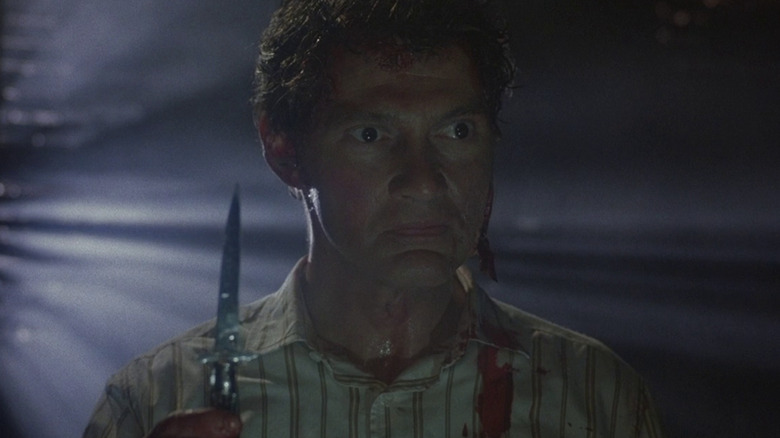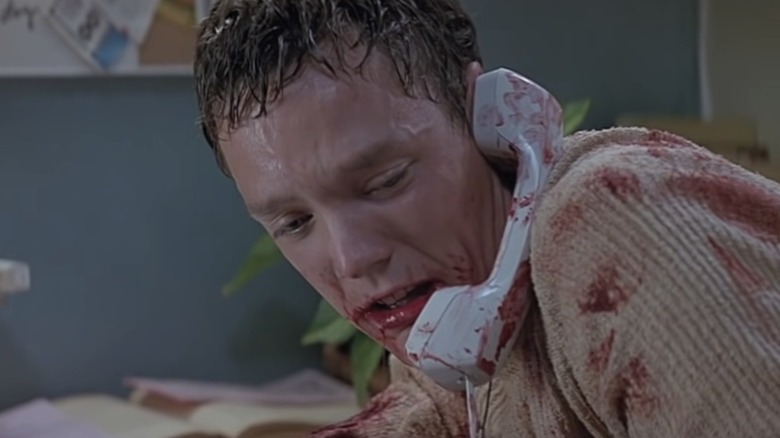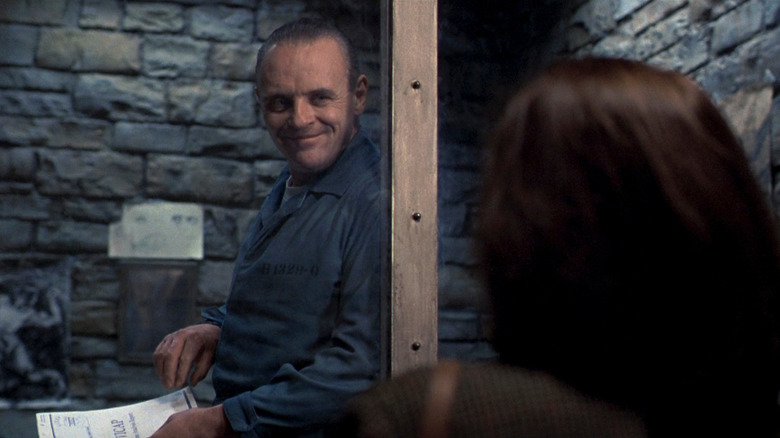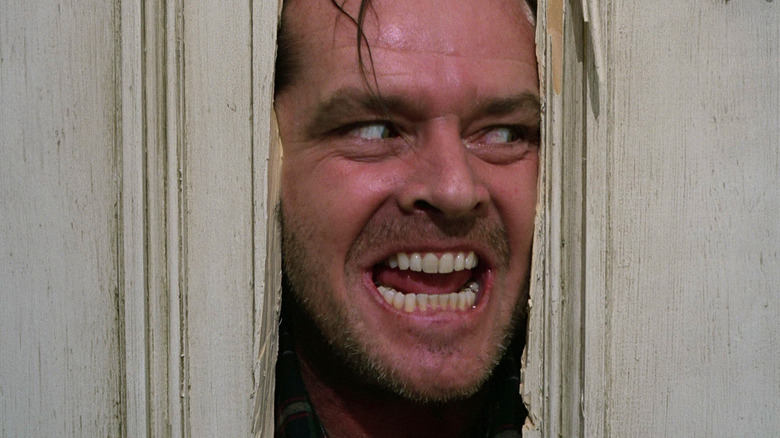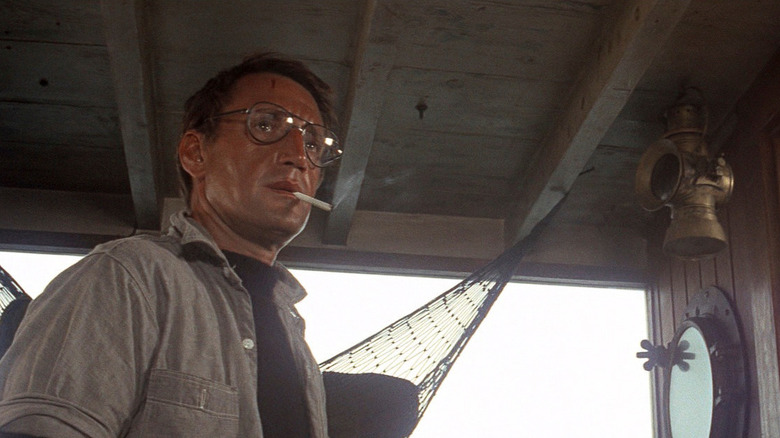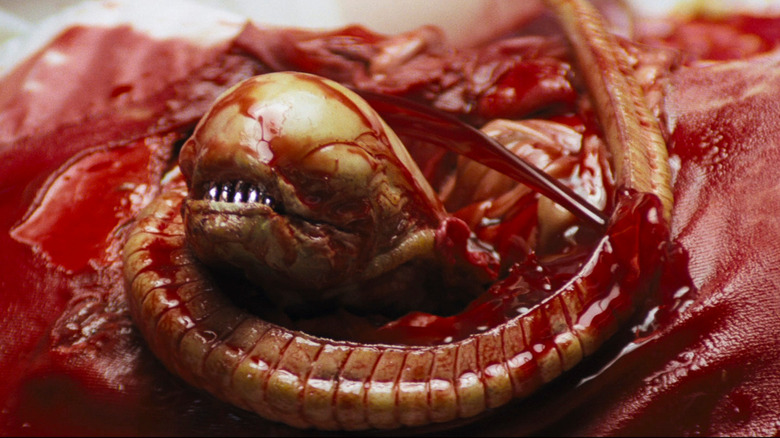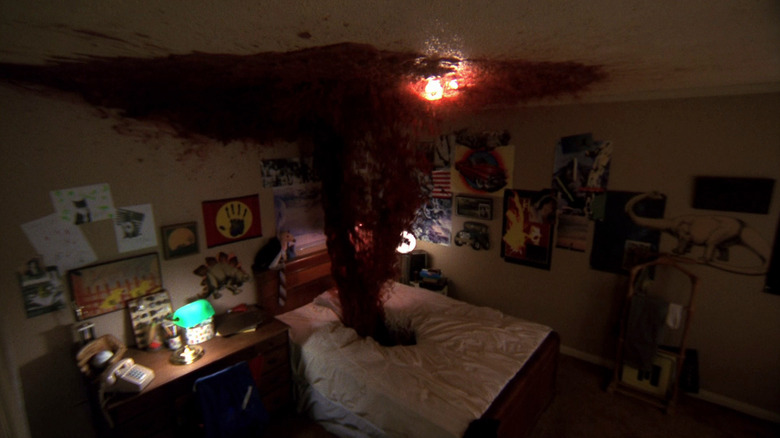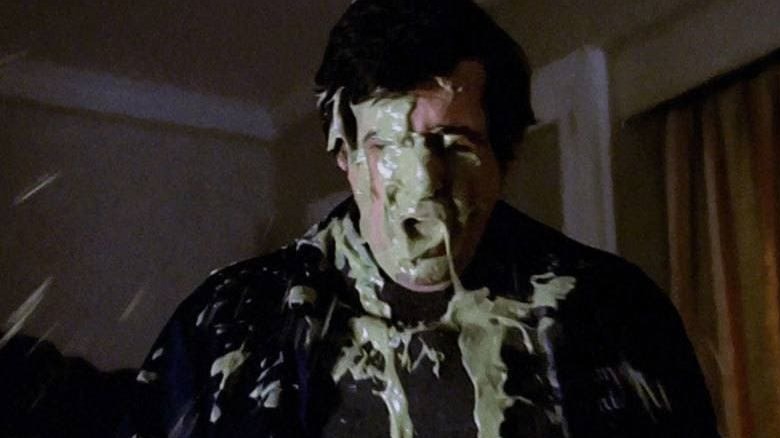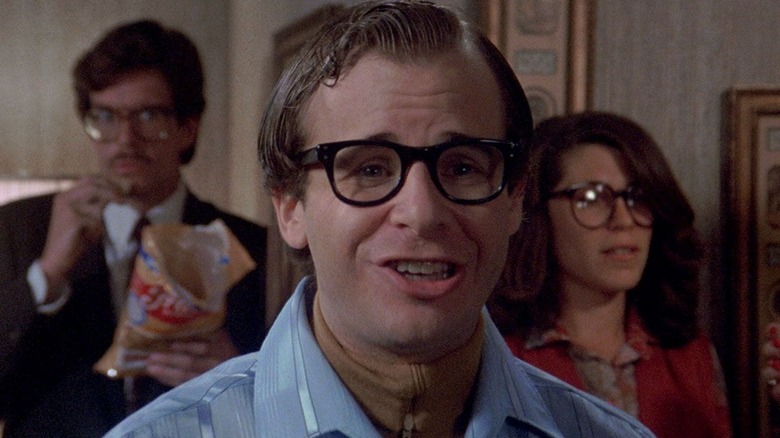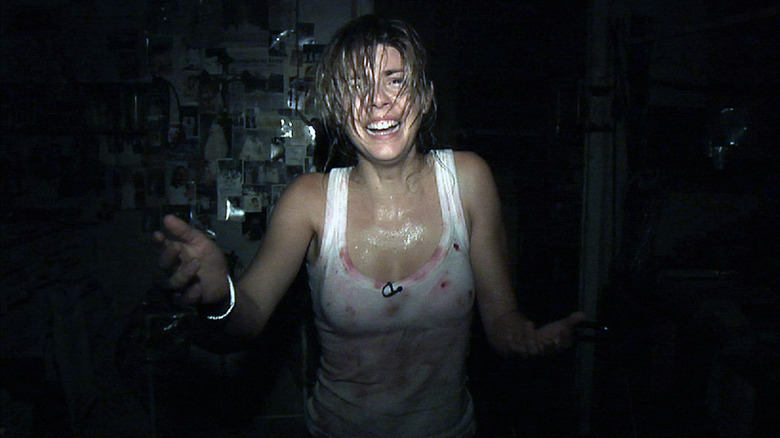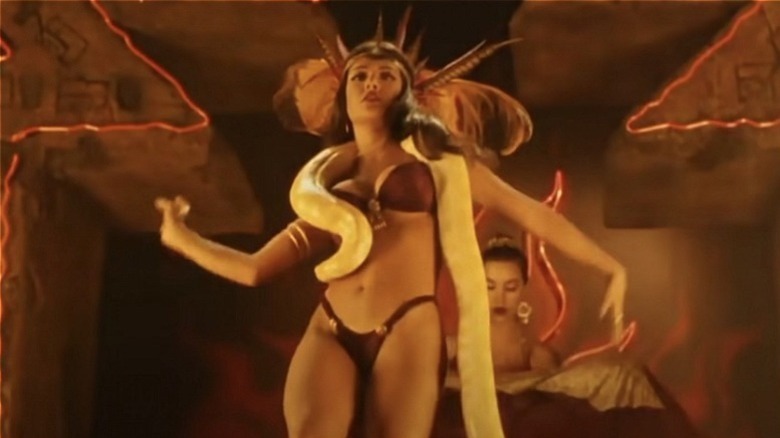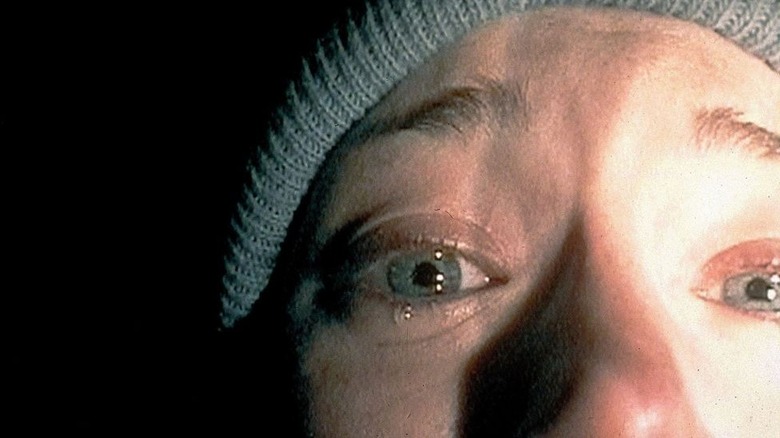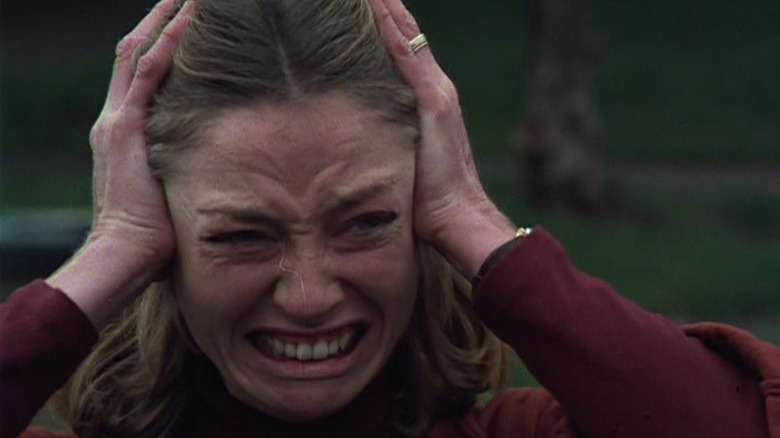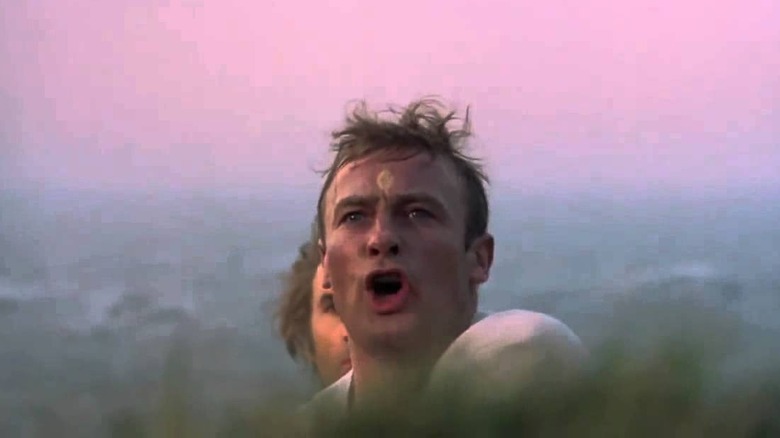Famous Horror Movie Scenes That Were Completely Improvised
Moviemaking is full of happy accidents. Sometimes special effects don't exactly go as planned, but the result is better than anything you could have imagined. Sometimes the original actor you wanted bails, but their replacement delivers the performance of a lifetime. There's always an element of random chance to making a movie; sometimes it's self-imposed, while other times it's a cruel machination of fate. And some of those moments of happenstance (be it a genuine accident or a creative lightning strike from the ad-lib gods) have formed the basis of some of cinema's most iconic moments.
Below, you'll find a selection of significant sequences from horror history that happened completely on the fly. Some of them are genius moments of improvisation and off-the-cuff instinct on the part of actors. Others are "imposed" method acting generated by simply not telling actors what to expect. It's a good lesson: You can plan all you like, but some of the greatest gems in life arrive when you least expect it.
Beware story spoilers for all of the films mentioned below.
Frank's iconic send-off in Hellraiser
Given that Clive Barker's feature film debut was based on a novella he wrote, you'd think he'd feel pretty strongly about "Hellraiser" sticking to the script. In an interview with The Guardian, Barker says that "By the mid-80s I'd had two cinematic abominations made from my stories," so he clearly has some strong feelings about how his work is translated to the screen. But Barker's a smart cookie, who knows genius when he sees it.
The genius moment in question came courtesy of Andrew Robinson. During his climactic scene as the perverted masochist Frank, he is torn apart by the chains of the Cenobites, who want to return their runaway freak to their Hell dimension. Right before the hooks estrange Frank's various parts from themselves, the weirdo licks his lips provocatively and proclaims: "Jesus wept."
As described in the documentary "Leviathan: The Story of Hellraiser and Hellbound: Hellraiser II," Robinson was originally supposed to utter the way less evocative "f**k you." However, he didn't feel like that line matched the greatness of the scene: "That's so, kind of, pedestrian. And so, I came up with the line. It was one of my favorite expressions. And Clive jumped on it." Robinson's decision to swap out the expletive for a phrase that expresses exasperation without being profane works perfectly here. In a moment where your flesh is being torn apart by inter-dimensional Hot Topic employees, what else could one say besides "Jesus wept."
Stu's bloody phone meltdown in Scream
At the conclusion of Wes Craven's 1996 meta-horror slasher "Scream," we finally learn who's behind mask of the ghost-faced killer that's been terrorizing the local teens. Turns out there wasn't just one knife-wielding maniac, but two: Billy (Skeet Ulrich), the bad boy boyfriend of heroine Sidney (Neve Campbell) and Stu (Matthew Lillard), an agent of chaos, who was just in on Billy's plan for the lolz. Stu doesn't have a personal vendetta or a tragic dark past. He just yes-and-ed himself into serial murder because how wild would that be?
As a result, when the demented duo enact the final step of their plan by stabbing each other to make it appear as though Sidney's dad attacked them, Stu does not take the "being stabbed" part very well. He babbles and hurls obscenities with the shock of a child who has just learned what consequences are. Amidst all the crying chaos, Sidney slips away, calls the cops, and proceeds to antagonize her stuck-pig assailants over the phone. Frustrated, Billy throws the phone across the room and it hits Stu, who hurls a hilariously bro-tinged j'accuse: "You f***ing hit me with the phone, dick!"
"Scream" writer Kevin Williamson notes on the blu-ray commentary for the film that Lillard improvised a huge chunk of his lines, including this one. In fact, this whole moment was unplanned, as Ulrich was supposed to throw the phone at the kitchen counter, but it slipped out of his fake bloody hands. Naturally, when Ulrich accidentally hit Lillard's noggin with the phone instead, Lillard retorted in character. What a professional.
A creepy punctuation to liver, fava beans, and a nice chianti in Silence of the Lambs
When aspiring FBI agent Clarice Starling (Jodie Foster) pays a visit to Hannibal "the Cannibal" Lecter (Anthony Hopkins), she learns exactly what the serial killer's nickname means thanks to a vivid anecdote from the man himself. "A census taker once tried to test me. I ate his liver with some fava beans and a nice chianti," the imprisoned murderer relays. What comes next is part hiss, part slurp, and all parts terrifying. Hopkins' vocalization is inhumane and visceral. It's a perfectly creepy thing for a madman like Hannibal to do and a disturbing demonstration of vulgarity from the polite-to-a-point psychopath.
The noise Hopkins makes wasn't in the film's screenplay but instead was something he added in at the last minute (via Far Out Magazine). In an interview with The Radio Times, Hopkins described the origin of the noise: "I don't know why but I've always known what scares people. When I was a kid I'd tell the girls around the street the story about Dracula. I'd go [he reproduces Lecter's legendary hiss]. They'd run screaming away." Hopkins' lifelong penchant for scaring people came in handy, as he opted to add in his weird little utterance to punctuate a take, director Jonathan Demme elected to keep it in, and the rest is horror history.
A tip of the hat(chet) to Johnny Carson in The Shining
What's your favorite part of Jack Nicholson's performance in "The Shining?" Is it during the film's ominously quiet opening moments, where the family man's strained smile belies his simmering insanity? Is it when the maddening tendrils of the Overlook Hotel begin to seduce an increasingly boozed-up Jack Torrance, alienating him from both his family and reality itself? Or is it in the film's final act, when the formerly (relatively) calm would-be-writer tears through anyone foolish enough to wind up on the pointy end of his ax? If you answered the latter, then it may interest you to know that the punctuation mark of Jack's madness was an improvised moment.
While his wife Wendy (Shelley Duvall) cowers in the bathroom, Jack hacks away at the feeble door with reckless abandon. Upon creating a suitable crack Jack peers through the porthole and manically proclaims: "Here's Johnny!" No such line appears in either Stephen King's book or Stanley Kubrick's script and was instead ad-libbed by Nicholson (via The Irish Times). Maybe Kubrick's infamously exhaustive takes drove Nicholson over the deep end. Maybe the actor is just a really big Johnny Carson fan. Either way, it's a terrifying moment. And the notoriously by-the-book Kubrick deserves credit for keeping the iconic line in the final cut.
A deadpan reaction to cinema's deadliest shark in Jaws
Picture this: You're out on a shark hunt. And when you least expect it, your prey emerges like a German U-Boat from the ocean's depths, summoned by all that delicious chum you've been dumping into the water. What do you say? If it were us, we'd probably shriek some colorful expletive. Maybe make a quiet prayer to the god of shark hunting. Sure, Brody (Roy Scheider) has seen the shark before but only in mere glimpses. A fin here. A thrashing tail there. Now, with the beastly creature's titular maw only feet from his face, Brody has a real sense of the beast of nature they're up against.
As Carl Gottlieb — scribe of "Jaws" — recalled to The Hollywood Reporter in 2016, Brody's famous, chilled utterance of "You're gonna need a bigger boat" wasn't so much a scripted line as an in-joke amongst the filmmakers. The "Jaws" shoot suffered from numerous difficulties, like producers refusing to spend money on a bigger support boat to steady the barge carrying all of the equipment.
"It became a catchphrase for any time anything went wrong — if lunch was late or the swells were rocking the camera, someone would say, 'You're gonna need a bigger boat.'" As Gottlieb told it, Scheider ad-libbed the line at various points throughout the shoot to try to get their inside gag into the final cut of the film. His persistence finally paid off in the scene when Brody gets up close and personal with the great white shark. As Gottlieb remembered: "It was so appropriate and so real and it came at the right moment."
The chaotic, chest-bursting breakfast in Alien
The "chestburster" scene in the 1979 sci-fi horror classic "Alien" is an absolute nightmare. While the crew of the Nostromo enjoys a pleasant group breakfast, we're well aware that something terrible is about to happen. Sure, Kane (John Hurt) says he feels great. But until very recently, the man had an alien horseshoe crab glued to his face. Sure enough, the incubating baby alien cracks its way through Kane's fragile human ribs, ripping its way through his guts, and flashing its pearly whites before zipping off into the air ducts to fully mature into the monstrous killer that will make the crew's short lives a living hell. But what really sells the scene — and what tips the sequence over into true, butt-clenching horror territory — is the crew's reactions. They look genuinely horrified. And that's because they were.
As relayed by The Take, Hurt was the only actor who knew what was going to happen (namely because he was outfitted with a prosthetic chest full of real animal organs and a compressed blood machine). But the rest of the cast was ushered off-set while Hurt was strapped in, so they could be kept totally in the dark. So, when they leaned in close over Hurt's fake torso, they got an unexpected face full of explosive gore and viscera. Sometimes to make genre film history you have to break a few ribs (and propel a few blood splatters at Veronica Cartwright ... who will feature again as an unsuspecting victim later on in this list).
The bloody bed geyser in A Nightmare on Elm Street didn't go according to plan
The majority of the entries on this list involve human ingenuity: Thespians who are quick on their feet, swift of mind, and creatively gifted. This is a story about human error. As described in the very long (and very good) making-of documentary "Never Sleep Again: The Elm Street Legacy," the scene in Wes Craven's "Nightmare on Elm Street" where a snoozing Glen Lantz (Johnny Depp) is sucked through his bed didn't go exactly as planned.
In the scene, a geyser of blood emerges from the bed after it "consumes" the teen. And just when you think "yeah, okay, I can get behind this," gravity stops working. Pooling on the ceiling, the blood begins to slosh from wall to wall like a crimson tide. It's an uncanny scene that perfectly captures the nightmare logic Freddy thrives on.
But filming the scene was a nightmare unto itself. The sequence was shot in a rotating room that was flipped upside down. The mission was simple: Pour fake blood into a hole and film it. The first problem was that they poured the red liquid onto a lamp, which electrocuted a crew member. As if that weren't bad enough, the now-electrified blood caused the room to roll all the way over. As Craven recalls in the documentary, the water "went into all the lights and there were these huge flashes in the dark ... we were spinning in the dark with all these sparks going on." All told, no one was seriously injured and the filmmakers were left with a trippier sequence than they'd expected. So, we're counting that as a win.
A pea soup facemask in The Exorcist
You know what they say: When life gives you lemons, make lemonade. Oh, sorry, did we say lemons? We meant projectile pea-green vomit. The possessed preteen in William Friedkin's 1973 classic goes through hell over the course of "The Exorcist." If the oozing lesions, cracked lips, and inhuman irises weren't unnerving enough, little Regan McNeil (Linda Blair) has to then turn into a puke-spewing fire hydrant. This targeted attack is directed squarely at the stern visage of the attendant Father Karras (Jason Miller). Karras reacts exactly like somebody who just got drowned in slime: gasping for breath and looking appropriately disgusted.
But if you look really closely, you can also detect a hint of uncharacteristic anger on the usually even-tempered priest. This is because Miller wasn't clued in on the target of the projectile vomit. In the BBC documentary "The Fear of God: 25 Years of 'The Exorcist,'" head of Special Effects Marcel Vercoutere notes that he was all set up to have the pea soup "vomit" hit Miller in the chest as scripted and rehearsed.
But delays in setting up the scene led to his vomit getting cold, so Vercoutere changed the trajectory of his rig and tilted it up towards Miller's face. Despite doing other takes with the vomit hitting Miller's chest, ultimately, it's his unscripted flummoxed reaction that made it into the final cut of the film.
The dinner party monologue from Ghostbusters was off-the-cuff
Canadian funnyman Rick Moranis appears in 1984's "Ghostbusters" as Louis Tully, a nerdy tax attorney whose proximity to Dana's apartment makes him a prime victim for the inter-dimensional machinations of Gozer. Right before Tully is possessed by the Keymaster, one of two demonic entities required to bring Gozer to earth, he hosts a massive party. It's one of the funniest scenes in the film (which is saying something), as Louis flits about with an absolute motormouth, introducing guests and selling the room-temperature brie like his life depends on it.
In an interview with Rolling Stone, the film's director Ivan Reitman shared that much of the scene was totally off-the-cuff on Moranis' part. "Rick just made all of it up as he was doing it," the director recalled. Given the actor's talents on the likes of The Second City's "SCTV," it's no surprise that Moranis was in his element while riffing as a nerdy (but undoubtedly charming) host. Just look at all those guests! He may be a pencil-pusher, but he's a popular guy.
None of the actors in [REC] knew what was coming next
Arguably one of the scariest films ever made, 2007's "REC" tells the increasingly chaotic tale of a two-person news team whose innocent ride along with the local fire department finds them stuck in a quarantined apartment with a mysterious outbreak. The apartment's residents are succumbing so an infection of unknown origin, turning them and their would-be helpers into homicidal maniacs.
As Jaume Balagueró, one of the film's co-directors, detailed to The Skinny, the goal was "to shoot the movie [in] the most organic and credible way. The actors never got the script, just a few pages with the general story. No dialogue at all. That's why we needed to shoot chronologically: they were discovering all the details of the story while we were shooting."
While we can think of plenty of moments from the film that would be absolutely terrifying to witness in-person without any warning, the climactic finale was especially scary for Manuela Velasco and Pablo Rosso, who play protagonists Ángela and Pablo. The news crew accidentally locates the source of the disease — a sick and monstrous girl known as "Niña Medeiros" — and they discover her in pitch darkness. Balagueró noted how scary it was for Velasco and Rosso because "Before that moment, they didn't know about [Niña Medeiros]. Nothing at all."
Salma Hayek improvised Santanico Pandemonium's dance
1996's "From Dusk Till Dawn" is what you get when you put vampires, Westerns, and siege thrillers together in a blender. The film sees two bad brothers (George Clooney and Quentin Tarantino) in a gorgeously set-decorated watering hole called the Titty Twister, awaiting the arrival of a partner in crime. Not long after the duo arrive, the very cool-named Santanico Pandemonium (Salma Hayek) performs a snake dance striptease. This is before the brothers discover that this bar in the middle of nowhere is also an ancient Aztec haunt for a coven of blood suckers ... so the dance is an enjoyable perk to their supposedly calm rendezvous stint.
In a Yahoo Role Recall interview, Hayek admitted that she has very few memories of filming the famous snake striptease because she went "on trance to do the dance" to cope with her fear of snakes. "There was no choreography," Hayek recalled. "It was improvised. Because you can't choreograph a snake, we don't know what she's going to do!" Well, that makes sssss-ense.
The script of The Blair Witch Project was extremely loose
"The Blair Witch Project" might not be the first found footage horror film (1980's "Cannibal Holocaust" precedes it by two whole decades). But it is one of the most influential, spawning imitators galore looking to capitalize on its massive runaway success. Filmed on commercially available camera equipment, a big part of what makes "The Blair Witch Project" so dang scary is its commitment to realism. It really feels like you've stumbled across tapes recording an ill-fated documentary crew. And a part of how the film's actual directors (Eduardo Sanchez and Daniel Myrick) captured that sense of visceral truthiness was by having almost the entire film be improvised.
As relayed in an oral history for Vice celebrating the film's 20th anniversary, the film's cast of three, inexperienced, nonunion actors were basically set loose in the Maryland wilderness to fend for themselves. They only had one hazy sense of anything resembling "a plan:" every night at the campsites, each actor would be given a film canister in a milk crate with special, top secret instructions that they were not allowed to share with one another.
"They, as actors, wouldn't know anything more than what their characters would know at the time," Myrick explained. So, for instance, when Joshua Leonard mysteriously vanishes in the middle of the night ... the other two cast members had no idea that was going to happen. As the actors tell it, they would have been genuinely terrified if they weren't so damp, cold, and exhausted from actually camping while making a film.
Veronica Cartwright didn't know the ending of Invasion of the Body Snatchers
A 1978 remake of a B-movie from the 1950s, Philip Kaufman's "Invasion of the Body Snatchers" spins a terrifying yarn about spores from outer space that quietly spread carbon copies of human beings into the general populace to take over the human race. In the film's final moments, it appears that our intrepid hero Matthew Bennell (Donald Sutherland) has somehow managed to evade the now massive swarm of alien-made clones. Weird. He seemed pretty cornered. Ah, well. Here he is, going peacefully about his day. Maybe he's found a way to fly under the radar and trick the aliens? That's what Nancy Bellicec (Veronica Cartwright) hopes when she sees her old friend. Then Matthew's jaw sloughs open, his eyes peeled wide, as he screams with the tell-tale accusatory shriek of an alien clone. Nancy is aghast, as are we.
But so was Cartwright, it turns out. As Kaufman relayed to The Hollywood Reporter, while Sutherland was clued into Kaufman's dire vision for the film's ending, Cartwright was left in the dark: "I don't remember that we even told Veronica until Donald turned and did that shriek." Kaufman's desire was to make an ending "that could truly be horrific," which is why he didn't share it with anyone — not even the studio execs. The result is uncanny: Cartwright looks genuinely shocked and terrified. Although, if you were suddenly faced with a shrieking Donald Sutherland, you might be pretty terrified too.
The reveal of the Wicker Man was a surprise to Edward Woodward
1973's "The Wicker Man" is one of the greatest horror slow burns out there. Plus, its climactic finale ends with an actual slow burn, so that earns it extra points. Sergeant Howie (Edward Woodward) doesn't know it, but his life is forfeit from the moment he sets foot on Summerisle. The island's residents aren't just hippie trash. They're genuine pagan cultists. And like their forefathers before them, a good harvest requires a good sacrifice. The film doesn't reveal its titular wicker man until its final, terrifying moments. And, unbeknownst to some viewers, our first time seeing the towering effigy was also Woodward's.
As Woodward relays in the making-of documentary "Burnt Offering: The Cult of the Wicker Man," the actor repeatedly declined to see the Wicker Man structure before the cameras rolled, wanting to preserve his organic reaction. And what a reaction it was. Sergeant Howe's aghast cries of "Oh God! Oh, Jesus Christ!" reverberate through folk horror history to this day. And much of the power of that reaction was in part because it was as much Woodward's as Howie's.
